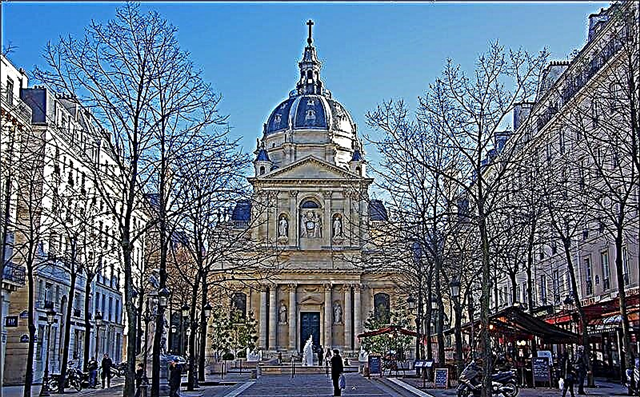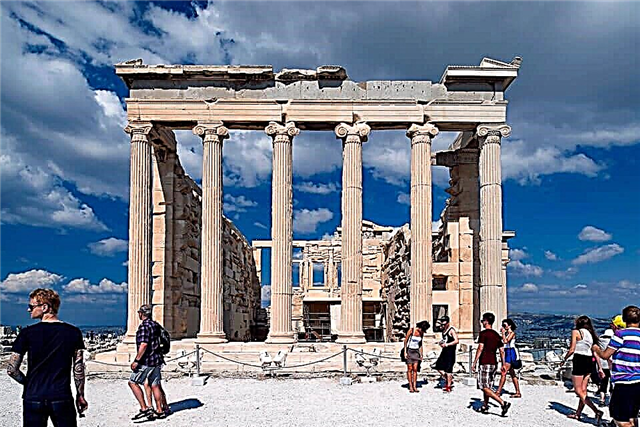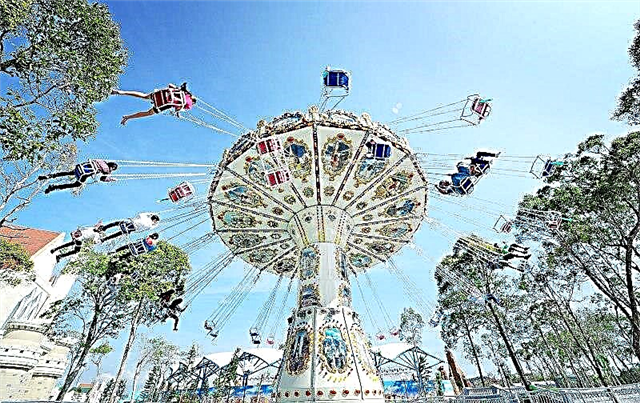Address: Italy, Milan
Start of construction: 1386 year
Start of construction: 1965 year
Coordinates: 45 ° 27'51.4 "N 9 ° 11'29.9" E
Content:
Short description
Duomo di Milano - symbol of Milan, dedicated to the birth of the Virgin Mary
Grandiose, stunning, magnificent, inimitable, luxurious, delightful ... - what grandiose epithets are awarded to Duomo di Milano - the cathedral located on the main square of Milan (with the same name)!

Bird's eye view of Milan Cathedral
But even they are unable to convey the feelings and impressions experienced by people who first saw it.
The gigantic white marble cathedral, executed in the ornate style of flaming Gothic (late Gothic architecture), has become a symbol of Milan and one of the most famous structures in the world. The official name of the cathedral is Santa Maria Nascente, it is dedicated to the Nativity of the Blessed Virgin Mary, but more often it is simply called the Milan Cathedral.
Starting to talk about it, the guides first of all mention the following facts: Duomo di Milano is the largest Gothic and 4th largest Catholic cathedral in the world after Notre Dame de la Paix in Yamoussoukro (Côte d'Ivoire), the cathedrals of St. Peter in Rome and St. Paul in London. In terms of its capacity, it is second only to the Cathedral of St. Peter (Rome) among the Catholic ones, and among the Gothic ones - to the Cathedral of Maria de la Sede (Sevilla). The total area of this building is 11.3 thousand square meters. m, height - 106.5 m. In clear weather, the peaks of the Alps are visible from the roof of the cathedral.
A more detailed acquaintance with the Milan Cathedral may take a long time, since its impressive size is far from its only advantage.

Facade of the cathedral
The history of the construction of the cathedral - a road ... 5 centuries long
The first stone of the future cathedral was laid by Archbishop Antonio di Saluzzo in 1386. In the times preceding this event, a Celtic settlement, the Temple of Minerva, the churches of Santa Tecla and Santa Maria Maggiore had already visited the same place. The last one was demolished, clearing the site for the Duomo di Milano.
This great structure was built from the best marble quarried in the Candolha quarries, located near the town of Mergozzo in Piedmont. Used for good purposes, this very valuable building material was not subject to tax on the orders of the then Duke Gian Galeazzo Visconti, who came to power. Nevertheless, despite the enormous popular and government enthusiasm that accompanied the construction of the cathedral, it lasted for many years, decades and even centuries.
The original development of the architectural project belonged to the Italian architect Simone de Orsenigo. Masters from other countries (Germany, France) were invited to build the cathedral, since complex Gothic facades were more typical for France than for Italy. Three years later, the Italian architect was replaced by a Frenchman - Nicolas de Bonaventure. Another 10 years later he was replaced by another Frenchman - Jean Mignot.

View of the Cathedral from Piazza Milan
In total, more than a dozen famous European architects managed to participate in the construction of the Milan Cathedral until 1470, in which the construction was headed by Juniforte Solari.... During this time, the cathedral turned from a 3-nave structure into a 5-nave one, the chapels disappeared from the project, and other significant and minor changes were made. Solari and his consultants Donato Bramante and Leonardo da Vinci made a very significant contribution to the creation of the architectural appearance of the cathedral: they decided to modernize the Gothic, diluting it with individual Renaissance elements. This is how the famous 8-sided dome was born.
In the following centuries, the temple slowly but surely continued to grow, be completed and decorated. A 106-meter central spire with a 4-meter statue of the Madonna, made of gilded bronze, was installed, for example, only in 1769. (The spire was designed by Francesco Croce, a statue by Giuseppe Perego). At the same time, by the way, a decree was issued prohibiting the construction of buildings in Milan that obscured its patron saint (alas, modernity has already begun to make its own adjustments - the first exception was the Pirelli skyscraper, the roof of which was decorated with an exact copy of the Madonna statue).

So it happened that work began on the creation of this white marble masterpiece of architecture in 1386, and was completed (and even then not completely) only in the 19th century, when the architects Karl Amati and Giuseppe Zanoya, on the personal order of Napoleon, urgently completed the design of the facade. The main altarpiece of the Duomo di Milano, when it was not even completed yet, in 1417, was consecrated by Pope Martin V.
The church opened its doors to parishioners in 1572; the grand opening was held by Cardinal Carl Borromeo, who later became a saint of the Catholic Church.
The remaining construction and finishing works were completed in the building of the cathedral until the second half of the last century. All this time, the cathedral was being completed, more and more decorative elements and stained-glass windows were found on its luxurious Gothic facade, the main gates were built. And only in 1965 the construction of the temple was officially completed. Nevertheless, even now there are still separate blocks of the facade, which have yet to be turned into sculptures.

Fragment of the facade of the cathedral
Despite the frequent change of architects, each of whom strove to bring something of his own into the building, Milan Cathedral is still an absolutely holistic work of art with a completely unique look. On the one hand, it has a distinct Gothic style that cannot be confused with any other. On the other hand, in its facade one can feel the North Italian, or more precisely, the Lombard influence, thanks to which the cathedral acquired a certain "earthiness" and ponderousness.
The eighth wonder of the world and its attractions
Late Gothic the building of Milan Cathedral is distinguished by a huge number of graceful spiers (135 marble needles), pointed turrets and columnsconnected by many soaring supports, the sophistication of the facades and an abundance of sculptures, of which there are more than 3 thousand outside and inside the cathedral. There are statues of biblical characters, chimeras, historical figures (Napoleon, Mussolini, etc.). From the roof of the cathedral, stunning panoramic views of Milan open up; it is recommended to climb here for every visitor who wants to get a full picture of this architectural masterpiece in particular and of Milan in general. The ascent can be carried out both by the stairs from the northern wall of the temple, and by a special elevator.

On the roofs of the cathedral
Duomo di Milano is able to amaze the imagination not only with its external appearance, but also with its interior decoration: the interior typical of the late Gothic style, mausoleums full of grandeur, unique wooden choirs of the 16th century (work of Francesco Brambigli), the highest cross vaults, huge arched windows with incredible colored stained-glass windows, some of which have survived from the 15th century, and much more. The temple looks huge and very solemn.
The inner space of the temple, which can simultaneously accommodate up to 40 thousand people, consists of 5 naves, separated by forty 25-meter columns. In front of the altar stands a 5-meter bronze Trivulzio candlestick with a very graceful base of bronze grapevine, made in the 12th century by Nicolas Verdune. And above the altar, under the very dome, the main shrine of the cathedral is kept - a sacred nail, which, according to legend, was taken directly from the Holy Crucifixion (from the cross of the Savior). Every year, on the Saturday closest to September 14, the nail is subject to a solemn removal - this action is performed by the archbishop, who rises to the nail on a lift, designed, as legend says, by Leonardo da Vinci himself.

The cathedral also houses the sarcophagi of several archbishops of Milan, dating back to the 14-18 centuries and made by the most famous Italian craftsmen. A notable distinguishing feature of the cathedral is the seemingly innumerable number of statues: only the interior of the 8-sided dome has 4 rows of 15 statues in each! The most famous in the cathedral is the statue of St. Bartholomew, created by Marco d'Agrate in 1562. The sculptures of Gian Giacomo Medici (Leone Leoni, 16th century), Martin V (Jacopino da Tradate, 15th century), Vladimir Monomakh attract attention.
Among other attractions of the temple, it is worth noting the "Meridian" - a sundial with the signs of the Zodiac (the sunbeam is unmistakably indicating the sign corresponding to the current month at noon); two large organs; three unique altars by Pellegrino Pellegrini; a 6th century Egyptian bath used as a baptismal font; and other works of art.
Milan Cathedral in the 21st century
Several years at the beginning of our century (until 2009) - Milan Cathedral was closed for reconstruction. Until this moment, restoration work in it was carried out only once - after World War II, when the building of the temple suffered from air raids. Now all the work has been completed, and the facade of the building again appeared before the residents and numerous guests of Milan in all its mighty glory.

Rear view of the cathedral
The dimensions of the cathedral, its luxurious and solemn appearance, incredibly generous interior decoration, full of events, the centuries-old history of the creation and existence of the temple - all this raises the Milan Cathedral to an unattainable height, making it one of the most famous world sights, which people from all over continue to see with their own eyes. the world.
Yes, today Milan Cathedral is open to visitors, but since it is a functioning temple it is worth showing respect and dressing to visit it according to some simple requirements: Cover bare shoulders and knees. Then you can safely get your share of impressions from this magnificence. If you still doubt whether to include it in your excursion program, keep in mind that you can truly appreciate the Milan Cathedral only with your own eyes. Not by video or by pictures.











